Ziyue Yang
Sigma-MoE-Tiny Technical Report
Dec 19, 2025Abstract:Mixture-of-Experts (MoE) has emerged as a promising paradigm for foundation models due to its efficient and powerful scalability. In this work, we present Sigma-MoE-Tiny, an MoE language model that achieves the highest sparsity compared to existing open-source models. Sigma-MoE-Tiny employs fine-grained expert segmentation with up to 96 experts per layer, while activating only one expert for each token, resulting in 20B total parameters with just 0.5B activated. The major challenge introduced by such extreme sparsity lies in expert load balancing. We find that the widely-used load balancing loss tends to become ineffective in the lower layers under this setting. To address this issue, we propose a progressive sparsification schedule aiming to balance expert utilization and training stability. Sigma-MoE-Tiny is pre-trained on a diverse and high-quality corpus, followed by post-training to further unlock its capabilities. The entire training process remains remarkably stable, with no occurrence of irrecoverable loss spikes. Comprehensive evaluations reveal that, despite activating only 0.5B parameters, Sigma-MoE-Tiny achieves top-tier performance among counterparts of comparable or significantly larger scale. In addition, we provide an in-depth discussion of load balancing in highly sparse MoE models, offering insights for advancing sparsity in future MoE architectures. Project page: https://qghuxmu.github.io/Sigma-MoE-Tiny Code: https://github.com/microsoft/ltp-megatron-lm
SIGMA: An AI-Empowered Training Stack on Early-Life Hardware
Dec 15, 2025Abstract:An increasing variety of AI accelerators is being considered for large-scale training. However, enabling large-scale training on early-life AI accelerators faces three core challenges: frequent system disruptions and undefined failure modes that undermine reliability; numerical errors and training instabilities that threaten correctness and convergence; and the complexity of parallelism optimization combined with unpredictable local noise that degrades efficiency. To address these challenges, SIGMA is an open-source training stack designed to improve the reliability, stability, and efficiency of large-scale distributed training on early-life AI hardware. The core of this initiative is the LUCIA TRAINING PLATFORM (LTP), the system optimized for clusters with early-life AI accelerators. Since its launch in March 2025, LTP has significantly enhanced training reliability and operational productivity. Over the past five months, it has achieved an impressive 94.45% effective cluster accelerator utilization, while also substantially reducing node recycling and job-recovery times. Building on the foundation of LTP, the LUCIA TRAINING FRAMEWORK (LTF) successfully trained SIGMA-MOE, a 200B MoE model, using 2,048 AI accelerators. This effort delivered remarkable stability and efficiency outcomes, achieving 21.08% MFU, state-of-the-art downstream accuracy, and encountering only one stability incident over a 75-day period. Together, these advances establish SIGMA, which not only tackles the critical challenges of large-scale training but also establishes a new benchmark for AI infrastructure and platform innovation, offering a robust, cost-effective alternative to prevailing established accelerator stacks and significantly advancing AI capabilities and scalability. The source code of SIGMA is available at https://github.com/microsoft/LuciaTrainingPlatform.
ProgRM: Build Better GUI Agents with Progress Rewards
May 23, 2025Abstract:LLM-based (Large Language Model) GUI (Graphical User Interface) agents can potentially reshape our daily lives significantly. However, current LLM-based GUI agents suffer from the scarcity of high-quality training data owing to the difficulties of trajectory collection and reward annotation. Existing works have been exploring LLMs to collect trajectories for imitation learning or to offer reward signals for online RL training. However, the Outcome Reward Model (ORM) used in existing works cannot provide finegrained feedback and can over-penalize the valuable steps in finally failed trajectories. To this end, we propose Progress Reward Model (ProgRM) to provide dense informative intermediate rewards by predicting a task completion progress for each step in online training. To handle the challenge of progress reward label annotation, we further design an efficient LCS-based (Longest Common Subsequence) self-annotation algorithm to discover the key steps in trajectories and assign progress labels accordingly. ProgRM is evaluated with extensive experiments and analyses. Actors trained with ProgRM outperform leading proprietary LLMs and ORM-trained actors, illustrating the effectiveness of ProgRM. The codes for experiments will be made publicly available upon acceptance.
MSCCL++: Rethinking GPU Communication Abstractions for Cutting-edge AI Applications
Apr 11, 2025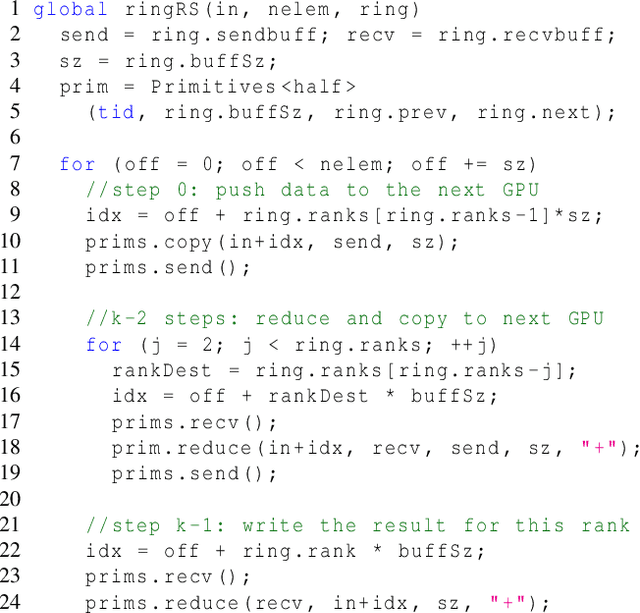

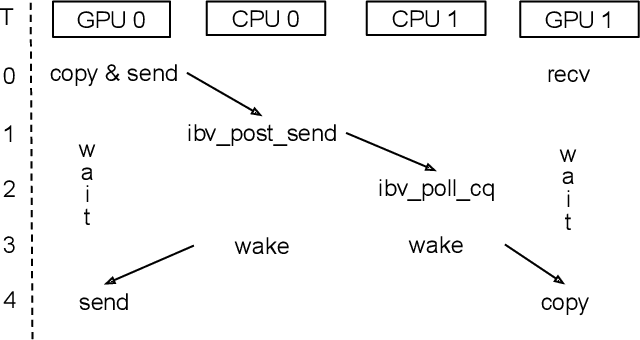
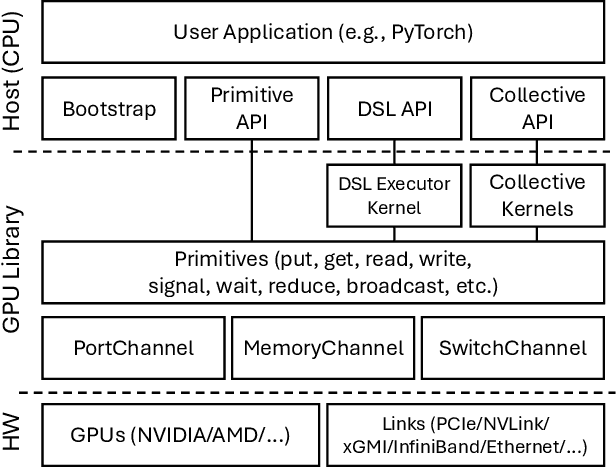
Abstract:Modern cutting-edge AI applications are being developed over fast-evolving, heterogeneous, nascent hardware devices. This requires frequent reworking of the AI software stack to adopt bottom-up changes from new hardware, which takes time for general-purpose software libraries. Consequently, real applications often develop custom software stacks optimized for their specific workloads and hardware. Custom stacks help quick development and optimization, but incur a lot of redundant efforts across applications in writing non-portable code. This paper discusses an alternative communication library interface for AI applications that offers both portability and performance by reducing redundant efforts while maintaining flexibility for customization. We present MSCCL++, a novel abstraction of GPU communication based on separation of concerns: (1) a primitive interface provides a minimal hardware abstraction as a common ground for software and hardware developers to write custom communication, and (2) higher-level portable interfaces and specialized implementations enable optimization for different hardware environments. This approach makes the primitive interface reusable across applications while enabling highly flexible optimization. Compared to state-of-the-art baselines (NCCL, RCCL, and MSCCL), MSCCL++ achieves speedups of up to 3.8$\times$ for collective communication and up to 15\% for real-world AI inference workloads. MSCCL++ is in production of multiple AI services provided by Microsoft Azure, and is also adopted by RCCL, the GPU collective communication library maintained by AMD. MSCCL++ is open-source and available at https://github.com/microsoft/mscclpp.
Uncertainty Aware Human-machine Collaboration in Camouflaged Object Detection
Feb 12, 2025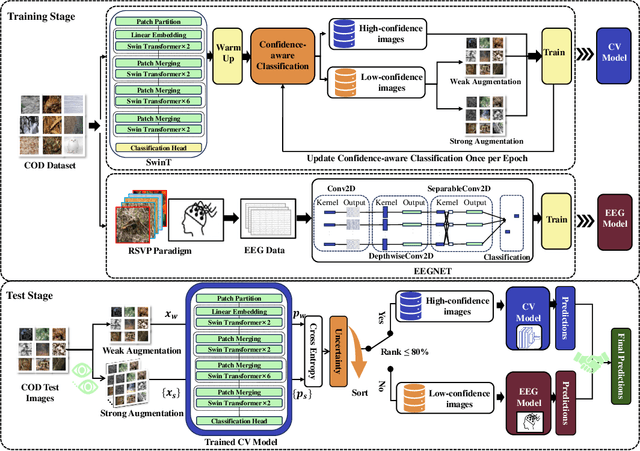
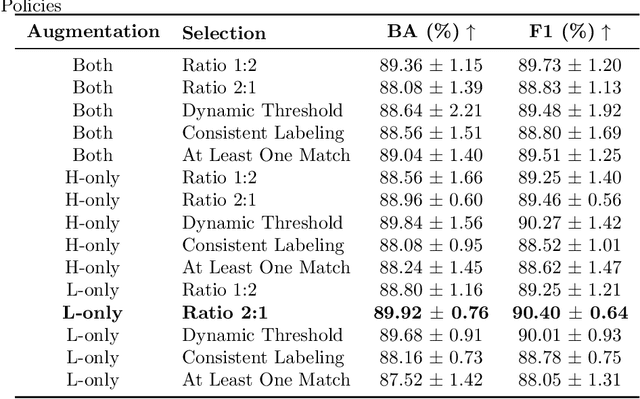
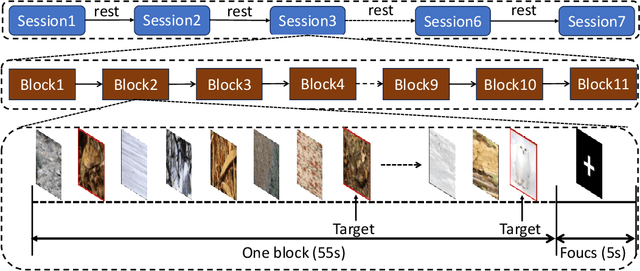
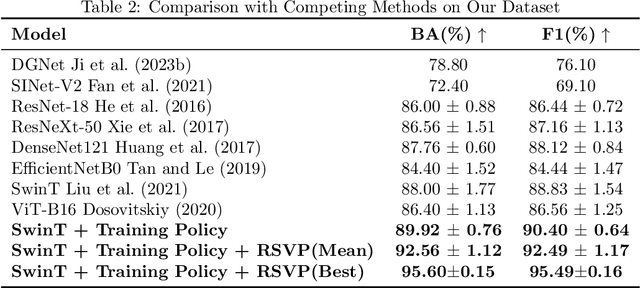
Abstract:Camouflaged Object Detection (COD), the task of identifying objects concealed within their environments, has seen rapid growth due to its wide range of practical applications. A key step toward developing trustworthy COD systems is the estimation and effective utilization of uncertainty. In this work, we propose a human-machine collaboration framework for classifying the presence of camouflaged objects, leveraging the complementary strengths of computer vision (CV) models and noninvasive brain-computer interfaces (BCIs). Our approach introduces a multiview backbone to estimate uncertainty in CV model predictions, utilizes this uncertainty during training to improve efficiency, and defers low-confidence cases to human evaluation via RSVP-based BCIs during testing for more reliable decision-making. We evaluated the framework in the CAMO dataset, achieving state-of-the-art results with an average improvement of 4.56\% in balanced accuracy (BA) and 3.66\% in the F1 score compared to existing methods. For the best-performing participants, the improvements reached 7.6\% in BA and 6.66\% in the F1 score. Analysis of the training process revealed a strong correlation between our confidence measures and precision, while an ablation study confirmed the effectiveness of the proposed training policy and the human-machine collaboration strategy. In general, this work reduces human cognitive load, improves system reliability, and provides a strong foundation for advancements in real-world COD applications and human-computer interaction. Our code and data are available at: https://github.com/ziyuey/Uncertainty-aware-human-machine-collaboration-in-camouflaged-object-identification.
Optimizing Large Language Model Training Using FP4 Quantization
Jan 28, 2025



Abstract:The growing computational demands of training large language models (LLMs) necessitate more efficient methods. Quantized training presents a promising solution by enabling low-bit arithmetic operations to reduce these costs. While FP8 precision has demonstrated feasibility, leveraging FP4 remains a challenge due to significant quantization errors and limited representational capacity. This work introduces the first FP4 training framework for LLMs, addressing these challenges with two key innovations: a differentiable quantization estimator for precise weight updates and an outlier clamping and compensation strategy to prevent activation collapse. To ensure stability, the framework integrates a mixed-precision training scheme and vector-wise quantization. Experimental results demonstrate that our FP4 framework achieves accuracy comparable to BF16 and FP8, with minimal degradation, scaling effectively to 13B-parameter LLMs trained on up to 100B tokens. With the emergence of next-generation hardware supporting FP4, our framework sets a foundation for efficient ultra-low precision training.
Sigma: Differential Rescaling of Query, Key and Value for Efficient Language Models
Jan 23, 2025



Abstract:We introduce Sigma, an efficient large language model specialized for the system domain, empowered by a novel architecture including DiffQKV attention, and pre-trained on our meticulously collected system domain data. DiffQKV attention significantly enhances the inference efficiency of Sigma by optimizing the Query (Q), Key (K), and Value (V) components in the attention mechanism differentially, based on their varying impacts on the model performance and efficiency indicators. Specifically, we (1) conduct extensive experiments that demonstrate the model's varying sensitivity to the compression of K and V components, leading to the development of differentially compressed KV, and (2) propose augmented Q to expand the Q head dimension, which enhances the model's representation capacity with minimal impacts on the inference speed. Rigorous theoretical and empirical analyses reveal that DiffQKV attention significantly enhances efficiency, achieving up to a 33.36% improvement in inference speed over the conventional grouped-query attention (GQA) in long-context scenarios. We pre-train Sigma on 6T tokens from various sources, including 19.5B system domain data that we carefully collect and 1T tokens of synthesized and rewritten data. In general domains, Sigma achieves comparable performance to other state-of-arts models. In the system domain, we introduce the first comprehensive benchmark AIMicius, where Sigma demonstrates remarkable performance across all tasks, significantly outperforming GPT-4 with an absolute improvement up to 52.5%.
SPFresh: Incremental In-Place Update for Billion-Scale Vector Search
Oct 18, 2024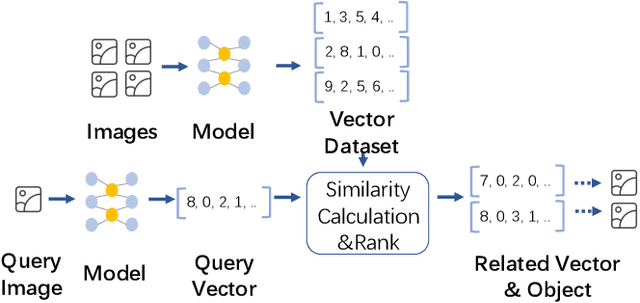

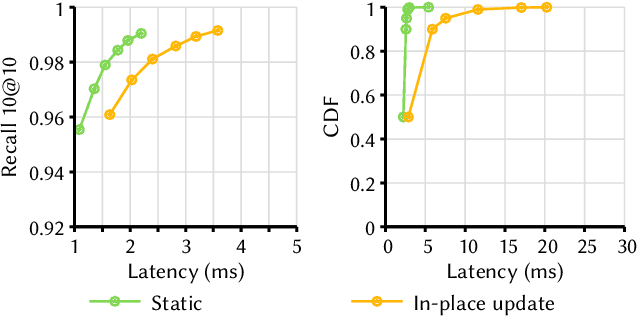
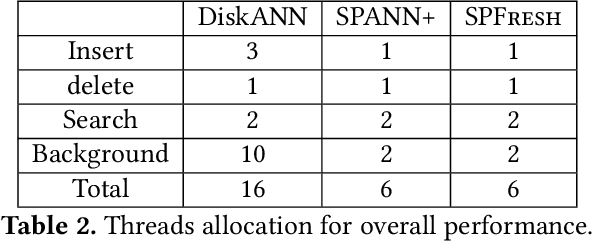
Abstract:Approximate Nearest Neighbor Search (ANNS) is now widely used in various applications, ranging from information retrieval, question answering, and recommendation, to search for similar high-dimensional vectors. As the amount of vector data grows continuously, it becomes important to support updates to vector index, the enabling technique that allows for efficient and accurate ANNS on vectors. Because of the curse of high dimensionality, it is often costly to identify the right neighbors of a single new vector, a necessary process for index update. To amortize update costs, existing systems maintain a secondary index to accumulate updates, which are merged by the main index by global rebuilding the entire index periodically. However, this approach has high fluctuations of search latency and accuracy, not even to mention that it requires substantial resources and is extremely time-consuming for rebuilds. We introduce SPFresh, a system that supports in-place vector updates. At the heart of SPFresh is LIRE, a lightweight incremental rebalancing protocol to split vector partitions and reassign vectors in the nearby partitions to adapt to data distribution shift. LIRE achieves low-overhead vector updates by only reassigning vectors at the boundary between partitions, where in a high-quality vector index the amount of such vectors are deemed small. With LIRE, SPFresh provides superior query latency and accuracy to solutions based on global rebuild, with only 1% of DRAM and less than 10% cores needed at the peak compared to the state-of-the-art, in a billion scale vector index with 1% of daily vector update rate.
ForestColl: Efficient Collective Communications on Heterogeneous Network Fabrics
Feb 09, 2024



Abstract:As modern DNN models grow ever larger, collective communications between the accelerators (allreduce, etc.) emerge as a significant performance bottleneck. Designing efficient communication schedules is challenging given today's highly diverse and heterogeneous network fabrics. In this paper, we present ForestColl, a tool that generates efficient schedules for any network topology. ForestColl constructs broadcast/aggregation spanning trees as the communication schedule, achieving theoretically minimum network congestion. Its schedule generation runs in strongly polynomial time and is highly scalable. ForestColl supports any network fabrics, including both switching fabrics and direct connections, as well as any network graph structure. We evaluated ForestColl on multi-cluster AMD MI250 and NVIDIA A100 platforms. ForestColl's schedules achieved up to 52\% higher performance compared to the vendors' own optimized communication libraries, RCCL and NCCL. ForestColl also outperforms other state-of-the-art schedule generation techniques with both up to 61\% more efficient generated schedules and orders of magnitude faster schedule generation speed.
FP8-LM: Training FP8 Large Language Models
Oct 27, 2023



Abstract:In this paper, we explore FP8 low-bit data formats for efficient training of large language models (LLMs). Our key insight is that most variables, such as gradients and optimizer states, in LLM training can employ low-precision data formats without compromising model accuracy and requiring no changes to hyper-parameters. Specifically, we propose a new FP8 automatic mixed-precision framework for training LLMs. This framework offers three levels of FP8 utilization to streamline mixed-precision and distributed parallel training for LLMs. It gradually incorporates 8-bit gradients, optimizer states, and distributed learning in an incremental manner. Experiment results show that, during the training of GPT-175B model on H100 GPU platform, our FP8 mixed-precision training framework not only achieved a remarkable 42% reduction in real memory usage but also ran 64% faster than the widely adopted BF16 framework (i.e., Megatron-LM), surpassing the speed of Nvidia Transformer Engine by 17%. This largely reduces the training costs for large foundation models. Furthermore, our FP8 mixed-precision training methodology is generic. It can be seamlessly applied to other tasks such as LLM instruction tuning and reinforcement learning with human feedback, offering savings in fine-tuning expenses. Our FP8 low-precision training framework is open-sourced at {https://github.com/Azure/MS-AMP}{aka.ms/MS.AMP}.
 Add to Chrome
Add to Chrome Add to Firefox
Add to Firefox Add to Edge
Add to Edge